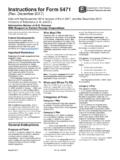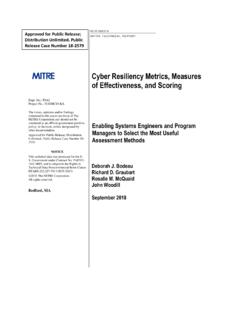Transcription of 2021 Instructions for Schedule J (Form 990)
1 Userid: CPMS chema: instrxLeadpct: 100%Pt. size: Draft Ok to PrintAH XSL/XMLF ileid: .. s/I990 SCHJ/2018/A/XML/Cycle02/source(Init. & Date) _____Page 1 of 6 16:47 - 1-Aug-2018 The type and rule above prints on all proofs including departmental reproduction proofs. MUST be removed before for Schedule J (Form 990)Compensation InformationDepartment of the TreasuryInternal Revenue ServiceSection references are to the Internal Revenue Code unless otherwise DevelopmentsFor the latest information about developments related to Schedule J (Form 990) and its Instructions , such as legislation enacted after they were published, go to InstructionsNote. Terms in bold are defined in the Glossary of the Instructions for Form 990, Return of Organization Exempt From Income of ScheduleSchedule J (Form 990) is used by an organization that files Form 990 to report compensation information for certain officers, directors, individual trustees, key employees, and highest compensated employees, and information on certain compensation practices of the II of Schedule J may be duplicated if additional space is needed.
2 Use as many duplicate copies of Part II as needed, and number each Must FileAn organization that answered Yes on Form 990, Part IV, line 23, must complete Schedule J. Do not file Schedule J for institutional an organization isn't required to file Form 990 but chooses to do so, it must file a complete return and provide all of the information requested, including the required InstructionsPart I asks questions regarding certain compensation practices of the organization. Part I generally pertains to all officers, directors, trustees, and employees of the organization listed on Form 990, Part VII, Section A, regardless of whether the organization answered Yes to line 23 of Part IV for all such individuals. However, only the organizations that are described in Who Must File, earlier, must complete Part I. Part I, lines 1, 2, 3, 7, 8, and 9 require reporting on the compensation practices of the filing organization, but not of related organizations.
3 Lines 4 through 6 require information regarding both the filing organization and its related organizations. Part I, lines 5 through 9, must be completed only by section 501(c)(3), section 501(c)(4), and section 501(c)(29) II requires detailed compensation information for individuals for whom the organization answered Yes on Form 990, Part IV, line 23. Not all persons listed on Form 990, Part VII, Section A, will necessarily be listed in Schedule J, Part III is used to provide explanations of answers as required in Part I or stated otherwise, all questions in this Schedule pertain to activity during the calendar year ending with or within the organization's tax I. Questions Regarding CompensationFor purposes of Part I, a listed person is a person listed on Form 990, Part VII, Section 1. Report information regarding certain benefits (if any) provided to persons listed on Form 990, Part VII, Section A, line 1a.
4 Check the appropriate box(es) if the organization provided any of the listed benefits to any of the persons listed on Form 990, Part VII, Section A, regardless of whether such benefits are reported as compensation on Form W-2, Wage and Tax Statement, box 1 or box 5, or Form 1099-MISC, Miscellaneous Income, box 7. For each of the listed benefits provided to or for a listed person, provide in Part III the following type of listed person who received the benefit, or a description of the types (for example, all directors) and number of listed persons that received the the benefit, or any part of it, was treated as taxable compensation to the listed travel refers to any travel on a passenger airplane, train, or boat with first-class seats or accommodations by a listed person or his or her companion if any portion of the cost above the lower-class fare is paid by the organization. First-class travel doesn't include intermediate classes between first class and coach, such as business class on commercial airlines.
5 Bump-ups to first class free of charge or as a result of using frequent flyer benefits, or similar arrangements that are at no additional cost to the organization, can be travel refers to travel on an airplane, train, or boat under a charter or rental arrangement. Charter travel also includes any travel on an airplane or boat that is owned or leased by the for companions refers to any travel of a listed person's guest not traveling primarily for bona fide business purposes of the organization. It also refers to any travel of a listed person's family members, whether or not for bona fide business indemnification and gross-up payments refer to the organization's payment or reimbursement of any tax obligations of a listed spending account refers to an account or sum of money under the control of a listed person with respect to which he or she isn't accountable to the organization under an accountable plan, whether or not actually used for any personal expenses.
6 Accountable plans are discussed in Accountable plan amounts, later (under Part II, column (D) Instructions ).Housing allowance or residence for personal use refers to any payment for, or provision of, housing by the organization for personal use by a listed person, including a ministerial housing or parsonage 01, 2018 Cat. No. 51525 QPage 2 of 6 Fileid: .. s/I990 SCHJ/2018/A/XML/Cycle02/source16:47 - 1-Aug-2018 The type and rule above prints on all proofs including departmental reproduction proofs. MUST be removed before for business use of personal residence refers to any payment by the organization for the use of all or part of a listed person's residence for any purpose of the or social club dues or initiation fees refers to any payment of dues by the organization for the membership of a listed person in a health or fitness club or a social or recreational club, whether or not such clubs are tax exempt.
7 It doesn't include membership fees for an organization described in section 501(c)(3) or section 501(c)(6) unless such organization provides health, fitness, or recreational facilities available for the regular use of a listed person. Health club dues don't include provision by the organization of an on-premises athletic facility described in section 132(j)(4), or provision by a school of an athletic facility available for general use by its students, faculty, and employees. Dues include the entrance fee, periodic fees, and amounts paid for use of such services refers to any services for the personal benefit of a listed person or the family or friends of a listed person, whether provided regularly (on a full-time or part-time basis) or as needed, whether provided by an employee of the organization or independent contractor (and whether the independent contractor is an individual or an organization).
8 They include, but aren't limited to, services of a babysitter, bodyguard, butler, chauffeur, chef, concierge or other person who regularly runs nonincidental personal errands, escort, financial planner, handyman, landscaper, lawyer, maid, masseur/masseuse, nanny, personal trainer, personal advisor or counselor, pet sitter, physician or other medical specialist, tax preparer, and tutor for nonbusiness purposes. Personal services don't include services provided to all employees on a nondiscriminatory basis under a qualified employee benefit 1b. If the organization provided any of the benefits listed in line 1a to one or more listed persons, answer Yes if the organization followed a written policy regarding the payment, provision, or reimbursement of all such benefits to listed persons. If the organization didn't follow a written policy for payment, provision, or reimbursement of any listed benefits, explain in Part III who determined the organization would provide such benefits and the decision-making 2.
9 Answer Yes if the organization required substantiation of all expenses or benefits listed on line 1a, in accordance with the rules for accountable plans discussed in Accountable plan amounts, later (under Part II, column (D) Instructions ), before reimbursing or allowing all such expenses incurred by any directors, trustees, and officers, including the organization's top management official (all referred to as top management official ). An organization can answer Yes if it checked the Discretionary spending account box on line 1a and required substantiation of expenses under the rules for accountable plans for all listed benefits on line 1a other than for discretionary spending 3. Check the appropriate box(es) to indicate which methods, if any, the organization used to establish the compensation of the organization's top management official. If the organization relied on a compensation consultant that used a method described in line 3 to help determine compensation for the top management official, the organization may check the box for that method in line 3.
10 Do not check any box(es) for methods used by a related organization to establish the filing organization's compensation of the filing organization's top management official. Explain in Part III if the organization relied on a related organization that used one or more of the methods described next to establish the top management official's committee refers to a committee of the organization's governing body responsible for determining the top management official's compensation package, whether or not the committee has been delegated the authority to make an employment agreement with the top management official on behalf of the organization. The compensation committee can also have other compensation consultant refers to a person outside the organization who advises the organization regarding the top management official's compensation package, holds himself or herself out to the public as a compensation consultant, performs valuations of nonprofit executive compensation on a regular basis, and is qualified to make valuations of the type of services provided.













